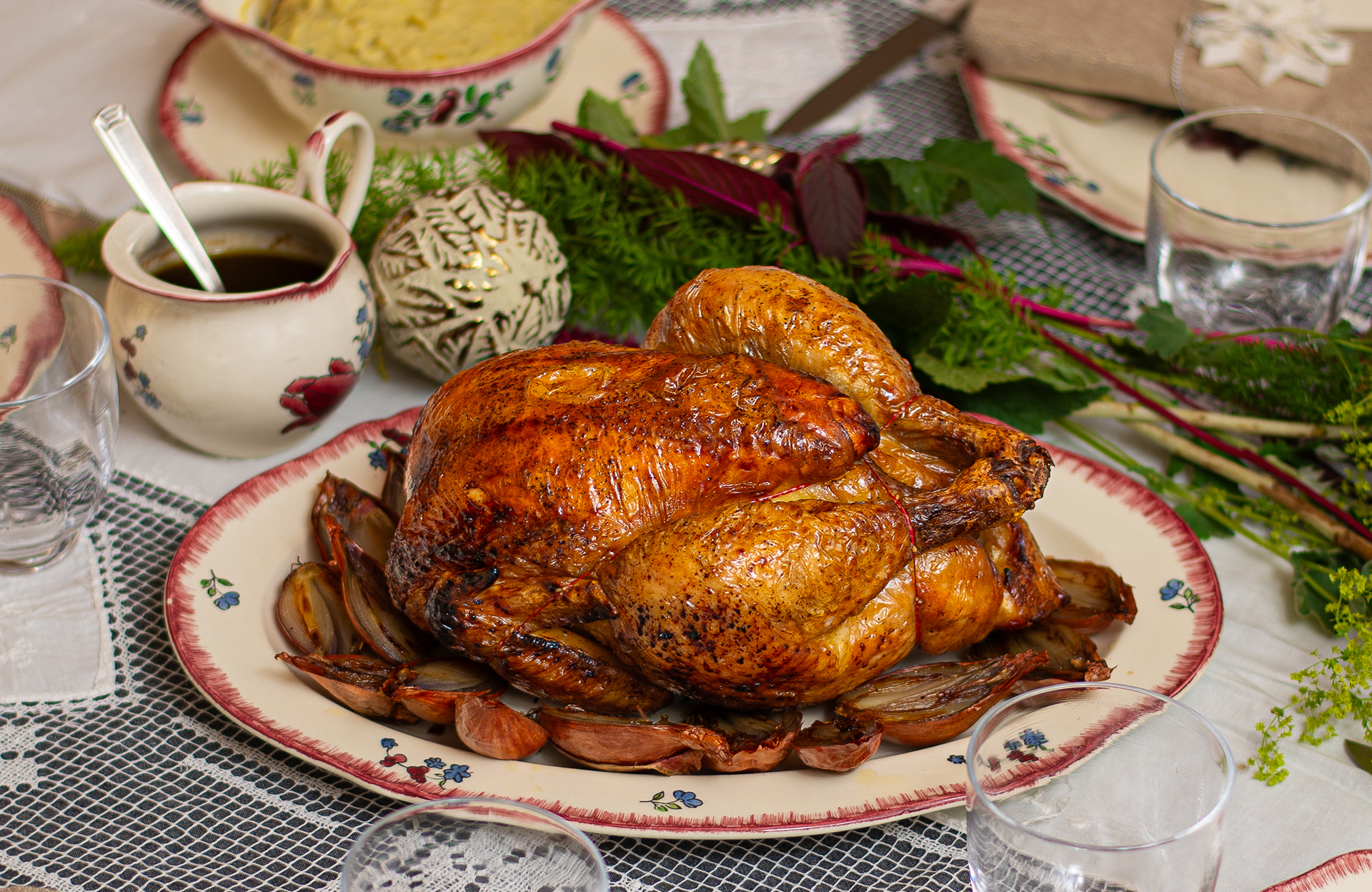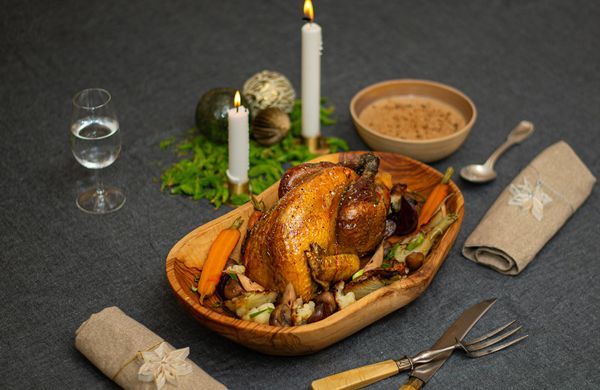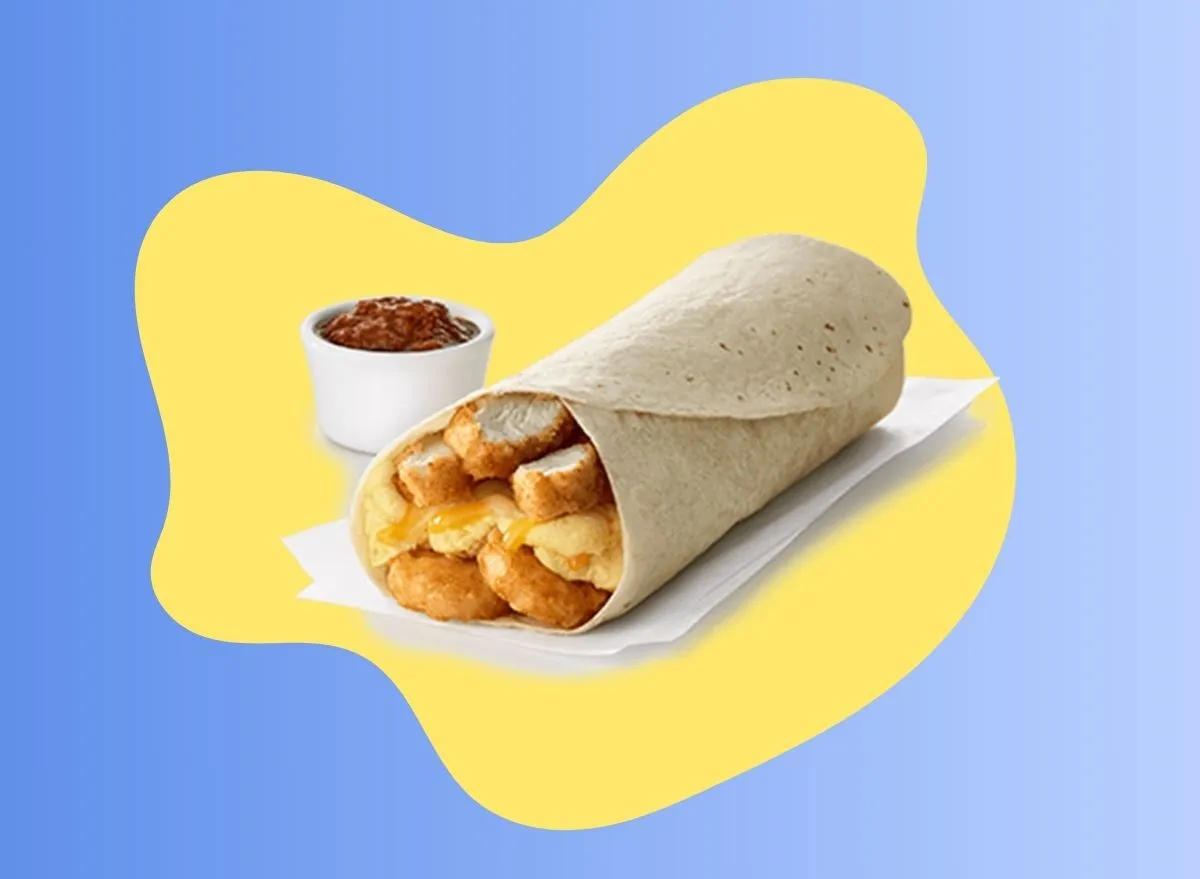
Chef Chloé Charles’s advice for cooking your Christmas poultry
SHE at the table. – How to choose your party poultry?
Chloe Charles. – I make sure to choose the fattest poultry possible. To the eye, it looks like yellow or white rolls depending on the color of the skin, at the bottom of the fillets or at the level of the thighs.
Also, I don’t buy it wrapped in plastic. Poultry is good when it dries.
For a festive poultry, for example, you can buy it between December 18 and 20 and keep it for 4 days in the open air in your refrigerator. This advice is valid for quality poultry that you buy from the butcher, which will keep for a long time, and not for pre-packaged poultry, which has spent several days in plastic film at the supermarket.
EAT. – In the supermarket, which product should you go for?
CC – There is often a butcher’s stand in the supermarket, you should try to go to it and if you have no choice, you can buy poultry ready to cook. On the other hand, when you arrive home, you have to unpack them and take them out of their plastic film. In fact, even if the animal is dead, the skin needs to breathe.
EAT. – And what about the famous Red Label?
CC – For me it’s obvious, but the poultry must obviously be farm-raised. The advantage of the Red Label is that it is rather quite drastic in terms of breeding conditions and so on. So, we choose at least Label Rouge poultry. Obviously, when you live in the region, the best thing is to know the breeders and go directly to their homes. But that doesn’t represent the majority of the population at all.
I like to coat it in fat with possibly a spice or other
EAT. – How to calculate the approximate weight of meat per person?
CC – To have eaten correctly, it is 130 and 150 g net, that is to say raw, without bones, and between 200 and 220 g with bones.
For information, if you want to be sufficiently committed and eco-responsible, it is advisable to consume – for your health and for the planet – 1 g per body weight per day. If you weigh 60 kg, you should consume 60 g of meat. But we have become accustomed to eating a lot more animal protein so when I say 130 to 150 g, in reality it may not seem like much to some, but it is already more than enough. Especially when we take into account a Christmas meal where, potentially, there will be salmon as a starter, foie gras, etc. It is a generally high protein meal in France.
It is also not worth planning on 200 g per person. Between 130 and 150 g of raw meat is already way too much, considering the whole meal.
The meal of an adult who eats normally – but we always eat more – is between 450 and 500 g of food. So, when I say that you need between 130 and 150 g of animal proteins, that’s already 1/3 of all that, knowing that in the 450, 500 g, this includes starter, main course, dessert.
EAT. – What are your tips for preparing holiday poultry?
CC – What I like to do is salt it at least 24 hours, or even 48 hours before. There is an author that I like, Arthur Le Caisne, who has just released a book “Go cook yourself an egg… to perfection”. He recommends putting a weird ingredient on your poultry: baking powder, to mix with salt then wipe off a little before cooking. I tried it, and it produced absolutely wonderful results! It changes the pH of the skin, making the skin ultra-crispy.
If you want to salt, you have to salt right on the skin and if you want to give a real taste to your poultry, you really have to salt it before and after. Ultimately, you can make a marinade just before. I like to coat it in fat with possibly a spice or other, but you have to do this just before cooking, there is no point in doing it before.
EAT. – How long to cook your Christmas poultry?
CC – We start with gentle cooking, 2 to 2.5 hours minimum at 140°C depending on the size of the poultry. Then, we leave it to rest for half an hour outside the oven while the oven heats up and we put it in the oven again for around 15 minutes at 250°C until it is nicely golden brown.
The other cooking method that is great is poaching. We don’t necessarily think about it, but you can make a vegetable broth with all the vegetable trimmings for example, and you poach the poultry in it before roasting it in the oven.
This technique is perfect, especially when you have farm capons, Label rouge, which are old animals, which have been outdoors for a long time, and can therefore have quite firm thighs. Which is not a fault. But cooking it first in broth will soften it a lot and give it flavor.
Concerning the poaching time, I would say that it is at least 2 hours, at a simmer. After 2 hours, it is really cooked. You can also poach it for 1 hour and finish cooking in the oven.
If you wait until the thighs are gray, the chicken is way overcooked
EAT. – How to calculate your cooking time in the oven based on the weight of the poultry?
CC – The huge advantage of cooking at 140°C is that it’s not close to 1/4 hour, it’s so low, you’re not going to make a mistake. We’re not even half an hour away!
The problem when you cook at 200°C for 1 hour 30 minutes is that you damage the flesh. And suddenly, it’s overcooked, it goes very quickly. At 140°C you can’t really go wrong.
All these tips apply to festive poultry but also to free-range chickens (cooking for 1.5 to 2.5 hours at 140°C).
Chef’s advice on cooking poultry
CC – Chicken thighs are naturally pink, because they contain a chemical substance, myoglobin, which is created when muscles are active. This is why there are none in the whites unlike the thighs which are more active. The mistake most people make is to think “as long as the thighs are pink, my chicken is not cooked”. But if you wait until the thighs are gray, the chicken is way overcooked.
On large birds like party birds, which have run a lot and are old, if you wait until your thighs are gray, the breasts next to them will be overcooked and dry.
If you hesitate to stop cooking, you can lift the thighs and cook the thighs and breasts separately. Or, or when the whites are cooked, we lift the thighs, we put only the thighs back in the oven and this allows the whites to be tender.
EAT. – What is the easy recipe you recommend?
CC – I like to put an aromatic garnish under the skin. I pass my hand around the neck, peel off the skin and underneath, you can put garlic butter, truffle, very toasted bread mixed with butter, this way the bread soaks up the juice and fat. meat is delicious. Plus, it’s pretty, with the transparency of the skin, you can see underneath.
With the carcass, you can make a broth and add the remains of shredded meat, some vegetables, small alphabet pasta…
EAT. – After cooking, I imagine you let your poultry rest? How long ?
CC – This is essential, especially with festive poultry.
What we usually say for small pieces is that the resting time equals the cooking time. When you cook poultry for 2 hours, there is no need to let it rest for 2 hours, if you already let it rest for 30 to 40 minutes, that is more than enough. People are afraid that with this resting time, it will get cold. In reality, it doesn’t cool and resting doesn’t necessarily mean out in the open in a cold room. We turn off the oven, we open it a little, otherwise there will be lots of steam and all the “energy” deployed to crisp the skin will be lost. So, we open it a little by putting a wooden spoon on the oven door, and it will drop in temperature very slowly. You can also turn your oven back on at 100°C for around ten minutes to reheat the poultry.
EAT. – What do you cook with leftover poultry?
CC – I make salads with very delicious vinaigrettes with oilseed butters – peanut, almond, tahini, almond cream – a little vinegar, water, salt and a spicy sauce. I coat my poultry in it, I add very crunchy salads such as romaine, thinly sliced and it gives a sort of Caesar salad. You can add small winter radishes or oven-roasted vegetables.
With the carcass, you can make a broth and put in the leftover shredded meat, a few vegetables, some small alphabet pasta and it makes a light post-holiday meal, which does no harm and allows you to finish the leftovers.
Knowing that during the holidays we throw away 3 kilos of food per household…
EAT. – Between the products left out of the fridge for too long that we don’t dare eat again, the leftover logs because we’re no longer hungry, the little piece of bread that has dried out, or the piece of cheese that We put aside for dessert, many of the ingredients end up at Madame Poubelle’s. So this year, no excuses, Christmas poultry is on the plate, not in the trash.

© Victoire Terrade
The recipe for Chaponnée Red Label farm guinea fowl, toasted bread cream and roasted seasonal vegetables from Chloé Charles
Preparation: 15 mins
Cooking time: 1 hour 05 minutes
For 4 people
1 capped farm guinea fowl Label rouge
Squash, Jerusalem artichoke, chestnuts, parsnips…
Butter
Salt pepper
Toast cream
50 cl of liquid cream
100g stale bread
For the caponée farm guinea fowl and vegetables
Arrange the whole guinea fowl with the vegetables around it in a baking dish.
Salt, pepper and butter generously.
In an oven preheated to 150°C with rotating heat, bake the caponné guinea fowl for 45 minutes. Then switch the oven to grill mode at 200°C for an additional 20 minutes. While cooking, baste the guinea fowl regularly with the cooking juices. Finally, let it rest for at least 30 minutes in the oven, slightly ajar.
Toast cream
Toast the bread cut into pieces in the oven at 200°C, in a separate dish, at the same time as the guinea fowl, for 5 to 6 minutes, until you obtain a deliberately deep golden brown color.
Cover the toasted bread with the liquid cream, let it soften, mix.
Dressage
Cut the guinea fowl and serve with vegetables, drizzled with toasted bread cream. Add the herb of your choice: tarragon, chives, parsley.

Russell age 28 years Studying in world cooking I have a degree in England
Studying in world cooking I have a degree in England

